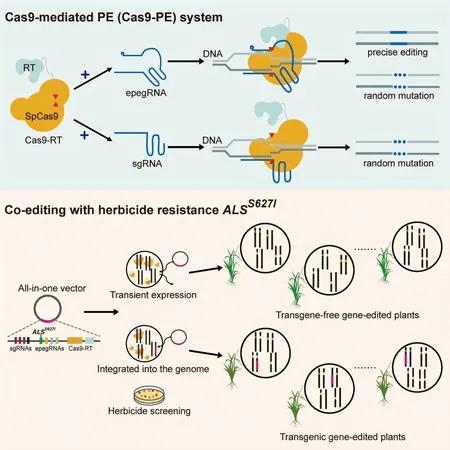
How Microplastics Could Be Altering Our Weather: Shocking New Research Reveals!
2024-11-17
Author: Wei
In a groundbreaking new study, scientists have discovered that microplastic pollution might be playing a surprising role in weather patterns. Traditionally, clouds form when water vapor — an invisible gas in our atmosphere — clings to tiny particles like dust, transforming into liquid water droplets or ice crystals. What’s startling is that these microplastic particles, which are less than 5 millimeters wide (about the size of a pencil eraser), can also initiate cloud formation at temperatures 5 to 10 degrees Celsius (9 to 18 degrees Fahrenheit) warmer than droplets without microplastics.
Researchers, who specialize in atmospheric chemistry, explain that this phenomenon could have significant implications for our weather and climate. The presence of microplastics may enable the formation of clouds under conditions that would otherwise be unsuitable for cloud creation, thereby influencing precipitation patterns globally.
Clouds are essential to Earth's weather system, composed of either liquid water droplets, ice particles, or a combination of both. In mid-to-upper atmosphere clouds, where temperatures can plunge to between 0 and -38 degrees Celsius (32 to -36 degrees Fahrenheit), ice crystals typically form around natural particles, including mineral dust and biological materials like pollen and bacteria. However, these tiny plastic pollutants have been discovered even in the most remote locations on Earth—from the uncharted depths of the Antarctic oceans to the icy peaks of Mount Everest, highlighting their pervasive presence in our environment.
The Plastic Precipitation Connection
Ice particles in clouds are crucial because most precipitation begins as ice. In nontropical regions, clouds often reach elevations where the cold air causes moisture to freeze. The process is straightforward: once ice forms, it attracts nearby water vapor, leading to larger ice crystals that eventually fall as precipitation. Without the formation of ice, clouds may simply dissipate, decreasing the likelihood of rain or snow.
Interestingly, many learn that water freezes at 0 degrees Celsius (32 degrees Fahrenheit), but without particles to nucleate around, some water droplets can remain in a supercooled state until temperatures drop as low as -38 degrees Celsius (-36 degrees Fahrenheit). This means that for water to freeze at higher temperatures, some solid material, like microplastics, must provide a surface for ice crystals to start forming.
Clouds also interact with the climate in myriad ways. They can either cool the Earth by reflecting sunlight or contribute to warming by absorbing radiation emitted from the surface. The balance between liquid water droplets and ice particles can shift dramatically based on the presence of microplastics, potentially changing how clouds affect Earth's energy balance.
Innovative Research Methodologies
To explore how microplastic particles might serve as nuclei for cloud formation, researchers tested four common plastic types found in the atmosphere: low-density polyethylene, polypropylene, polyvinyl chloride, and polyethylene terephthalate. These plastics were evaluated both in their original state and after exposure to conditions that mimic atmospheric effects, like ultraviolet light, ozone, and acidic environments.
The experimental approach involved suspending microplastics in small water droplets and gradually cooling them to see when they froze. The results were revealing—50% of the microplastic-infused droplets froze at around -22 degrees Celsius (-8 degrees Fahrenheit). This phenomenon aligns with findings from Canadian scientists, corroborating the notion that certain microplastics promote ice formation at higher temperatures than droplets without microplastic content.
While exposure to specific atmospheric elements can diminish the ice nucleation ability of microplastics, they still play a significant role in influencing cloud formation.
Unanswered Questions Looming Ahead
Despite these promising discoveries, researchers face significant unknowns. To fully assess the impact of microplastics on weather and climate, it is vital to understand their concentration in cloud-forming altitudes and how these levels stack up against other natural nucleating agents like mineral dust and biological particles. These insights could pave the way for accurate models predicting how microplastics are reshaping our climate.
The research journey doesn't stop here. Future studies will delve deeper into the effects of plastics that include additives like plasticizers and colorants, and explore smaller plastic particles, aiming to grasp the full extent of microplastic pollution's influence on our atmosphere.
The implications of this research could be vast, potentially redefining how we view climate change and pollution. As the world faces an escalating plastic crisis, understanding its impacts in the atmosphere may be more critical than ever. Stay tuned for further developments in this alarming intersection of plastic pollution and weather dynamics!





 Brasil (PT)
Brasil (PT)
 Canada (EN)
Canada (EN)
 Chile (ES)
Chile (ES)
 España (ES)
España (ES)
 France (FR)
France (FR)
 Hong Kong (EN)
Hong Kong (EN)
 Italia (IT)
Italia (IT)
 日本 (JA)
日本 (JA)
 Magyarország (HU)
Magyarország (HU)
 Norge (NO)
Norge (NO)
 Polska (PL)
Polska (PL)
 Schweiz (DE)
Schweiz (DE)
 Singapore (EN)
Singapore (EN)
 Sverige (SV)
Sverige (SV)
 Suomi (FI)
Suomi (FI)
 Türkiye (TR)
Türkiye (TR)